QuickStart
For many people, visualizing their dream home does not start with the outside shape of the building, but with a wish list of individual rooms. Now you can create complex floor plans from the inside out, by laying out your home design room by room. Create entire rooms with one click of the mouse! Build an entire floor in just seconds, with Punch! QuickStart.
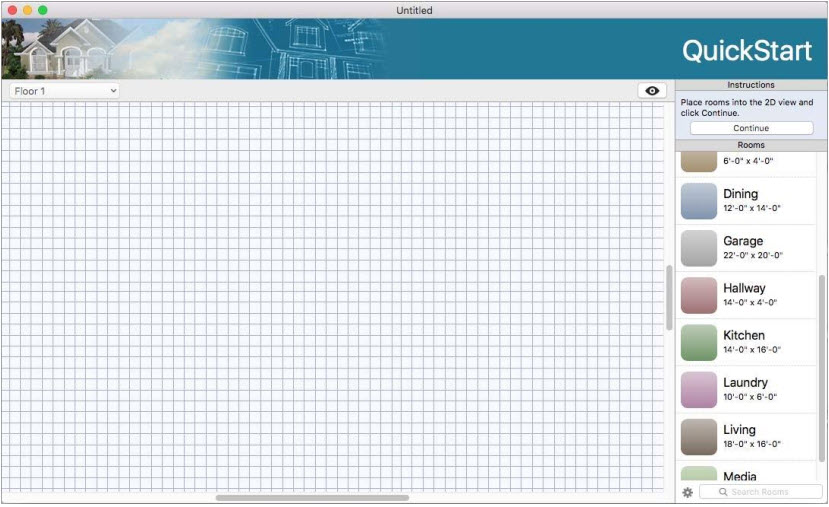
Launching QuickStart
By default, QuickStart launches automatically upon starting the application. You change the interface preferences so that the application opens directly to the design window instead of QuickStart if you prefer.
To control QuickStart display
1 Choose Home Design Studio > Preferences (or press Command-,).
2 Click the General tab and from the When creating a new design pop-up menu, choose to Start in QuickStart to open in QuickStart or choose to start with a blank design to open to the design window.
3 Click Save.
Show Welcome Window at Startup
You can toggle the initial Welcome window on and off depending on your preferences. The Welcome window offers options for starting a new design or opening a design you’ve been working on. Additionally, the Welcome window provides access to training material, sample plans, and special offers specifically for Punch! users.
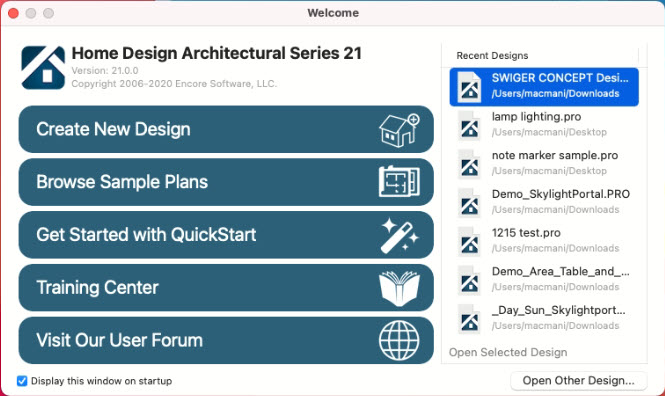
When creating a new design, you’ll then specify your project settings. For more information on project settings, see“Floor Settings”.
To hide Welcome window at startup
1 Choose Home Design Studio > Preferences (or press Command-,).
2 Click the General tab and deselect the “Display the welcome window” checkbox.
3 Click Save.
(alternatively) When the Welcome window is open, deselect the “Display this window on startup” checkbox.
To show Welcome window at startup
1 Choose Home Design Studio > Preferences (or press Command-,).
2 Click the General tab and select the “Display the welcome window” checkbox.
3 Click Save.
Floor Settings
When beginning a new project, you can start designing immediately using the default floor settings, or specify particular settings to be used throughout your design, such as the number of floors or ceiling heights. By default, the Project Assistant launches automatically upon starting the application. You change the interface preferences so that the Project Assistant window does not appear. In this case, you can edit the floor properties from the Floors pop-up menu on the toolbar. You have the option to specify the bottom floor as a basement. When this option is selected, the Basement Properties appear, and the diagram is updated to include a basement level.
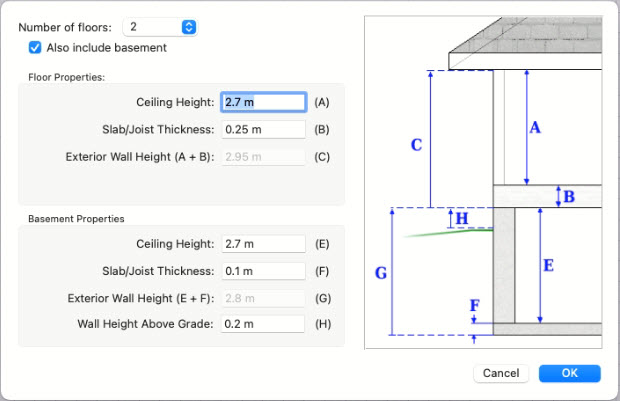
To setup a project without a basement
1 From the Number of floors pop-up menu, choose the total number of floors you want in your project.
2 Under Floor Properties, enter the ceiling heights and slab/joist thickness in the corresponding fields. The exterior wall height is the sum of the ceiling heights and slab/joist thickness, so it is not editable.
3 Enter the ground floor slab/joist thickness in the corresponding field.
4 Click OK.
To setup a project with a basement
1 From the Number of floors pop-up menu, choose the total number of floors you want in your project.
2 Select the “Also include basement” checkbox. The Basement Properties appear.
3 Under Floor Properties, enter the ceiling heights and slab/joist thickness in the corresponding fields. The exterior wall height is the sum of the ceiling heights and slab/joist thickness, so it is not editable.
4 Under Basement Properties, enter the ceiling height and slab/joist thickness in the corresponding fields. The exterior wall height is the sum of the ceiling height and joist thickness, so it is not editable.
5 In the Wall Height Above Grade field, enter a value to specify how much of the basement you want to appear above grade.
Note: The Wall Height Above Grade value does not affect the overall wall height, it only specifies how much of the exterior wall height is above grade.
6 Click OK.
To control Project Assistant display
1 Choose Home Design Studio > Preferences (or press Command-,).
2 Click the General tab and select the “Show the project assistant” checkbox to show the assistant when opening a new file or deselect the checkbox to hide the assistant when opening a new file.
3 Click Save.
4 from the When creating a new design pop-up menu, choose to Start in QuickStart to open in QuickStart or choose to start with a blank design to open to the design window.
5 Click Save.
Adding Rooms
You can create rooms with a few simple clicks of the mouse. Punch! allows you to use predesigned room dimensions and customize these dimensions, or create your room from scratch. The QuickStart toolbar features eleven color-coded room types, as well as the option to create a custom room to be saved in the toolbar. Simply drag your room type into the design window and change your room’s dimensions if you wish. When you’re finished placing rooms, click the Continue button to update your design
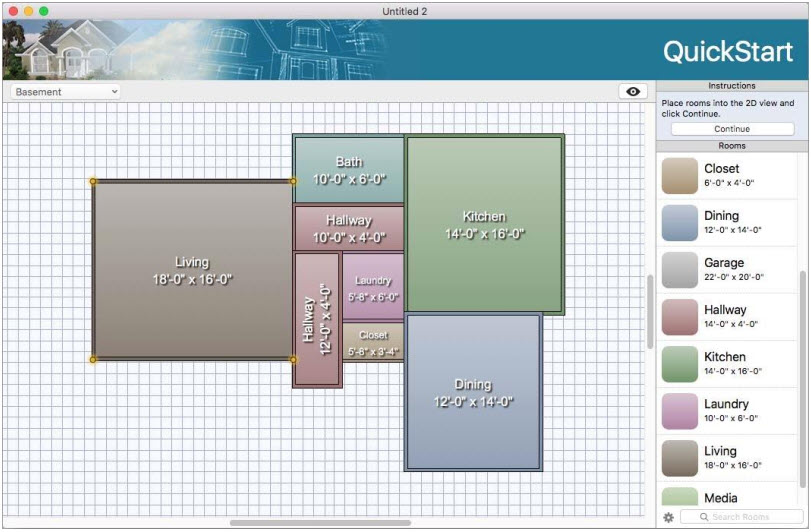
To control which floor you are working on, see “Work on Floor”.
To place auto-sized rooms
1 Click to select the room you want to place and then click in the design window to place the room. Continue to place rooms until you’ve created the desired design.
2 Click the Continue button to edit your design in the design window.
To control the visibility of overlapping rooms
■ Double-click the room you want to bring to the front.
To resize rooms
■ Select the room you want to resize and drag a corner point to the desired size.
Customizing Rooms
In addition to the predefined rooms available for quick placement, you can create custom rooms to add to the toolbar. When you add a new room, you define the room name, the dimensions, and the color used to identify the room. You can also edit the name, size, and color of rooms, as well as delete rooms from the toolbar.

To create a room for placement
1 Click the gear  button and choose Add Room from the Action pop-up menu. The Add QuickStart Room dialog appears.
button and choose Add Room from the Action pop-up menu. The Add QuickStart Room dialog appears.
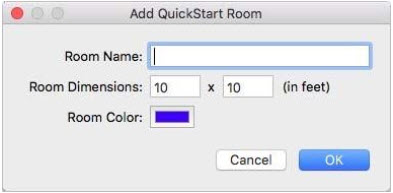
2 Enter a Room Name in the field.
3 Specify the Room Dimensions in the fields (in feet).
4 Click the Room Color preview color and choose a color to represent the room, then close the window.
5 Click OK. The room is updated in the toolbar.
To edit room properties
1 Select the room you want to edit in the toolbar.
2 Click the gear  button and choose Edit Room from the action pop-up menu. The Edit QuickStart Room dialog appears.
button and choose Edit Room from the action pop-up menu. The Edit QuickStart Room dialog appears.
3 Change the Room Name, Room Dimensions, or Room Color and then click OK.
To delete a room
1 Select the room you want to delete in the toolbar.
2 Click the gear button and choose Delete Room from the action pop-up menu. The room is removed from the toolbar.
Viewing a QuickStart Design in 3D
As you design in QuickStart, you can see a 3D view of your design before you begin to continue with your drawing in the design window. Note: For information on navigating in 3D, rendering styles, and other render settings, see “Control 3D Options”

To see a 3D view in QuickStart
1 Choose the 3D View button  in the toolbar. A 3D View appears.
in the toolbar. A 3D View appears.
2 Use the navigations tools, available in the 3D View toolbar, to navigate around the drawing.